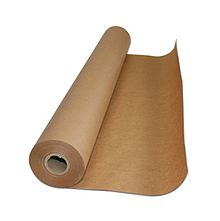This articleneeds additional citations forverification.(October 2011) |
Kraft paperorkraft[1]ispaperorpaperboard(cardboard) produced fromchemical pulpproduced in thekraft process.

Sack kraft paper(or justsack paper) is a porous kraft paper with highelasticityand high tear resistance, designed for packaging products with high demands for strength and durability.[2]
Pulp produced by the kraft process is stronger than that made by otherpulping processes;acidicsulfite processesdegradecellulosemore, leading to weaker fibers, and mechanical pulping processes leave most of theligninwith the fibers, whereas kraft pulping removes most of the lignin present originally in the wood. Low lignin is important to the resulting strength of the paper, as thehydrophobicnature of lignin interferes with the formation of thehydrogen bondsbetween cellulose (andhemicellulose) in the fibers.[3]
Kraft pulp is darker than other wood pulps, but it can bebleachedto make very white pulp. Fully bleached kraft pulp is used to make high quality paper where strength, whiteness, and resistance to yellowing are important.
Manufacture
editWood pulpfor sack paper is made fromsoftwoodby thekraft process.The long fibers provide the paper its strength andwet strength chemicalsare added to even further improve the strength. Both white and brown grades are made. Sack paper is then produced on apaper machinefrom the wood pulp. The paper ismicrocreppedto give porosity and elasticity. Microcrepping is done by drying with loose draws allowing it to shrink. This causes the paper to elongate 4% in the machine direction and 10% in the cross direction without breaking.[2]Machine direction elongation can be further improved by pressing between very elastic cylinders causing more microcrepping.[2]The paper may be coated withpolyethylene(PE) to ensure an effective barrier againstmoisture,greaseandbacteria,although recyclability is hindered.Zeincoatings are also water resistant but allow better recyclability.[4]
A paper sack can be made of several layers of sack paper depending on the toughness needed.
Kraft paper is produced on paper machines with moderate machine speeds. The raw material is normallysoftwoodpulp from the kraft process.
Maintaining a high effective sulfur ratio or sulfidity is important for the highest possible strength using the kraft process.
The kraft process can use a wider range of fiber sources than most other pulping processes. All types of wood, including very resinous types like southernpine,[5]and non-wood species likebambooandkenafcan be used in the kraft process.
Qualities
edit- Normal kraft paper is strong and relatively coarse. It has hightensile strength.Thegrammageis normally 40–135 g/m2.
- Sack kraft paper, or just sack paper, is a porous kraft paper with high elasticity and high tear resistance, designed for packaging products with high demands for strength and durability.
- Absorbent kraft paper is made with controlled absorbency (i.e. a high degree of porosity). It is made of clean lowkappahardwoodkraft and has to have a good uniformity and formation.
- Spinning kraft paper is an especially strong type of kraft paper with relatively low grammage (40 g/m2). This paper requires the best possible machine direction strength and cross machine elongation. This is done by high fiber orientation on the paper machine.
- Hunting cartridge paper is a kraft paper used inshotgun shells.This paper needs a high tensile strength in the machine direction, which is the axial direction of the cartridges. In the cross direction, the cartridge is supported by the gun-pipe, but a sufficient elongation is needed. The body of the cartridge is wound of a kraft paper of 80–120 g/m2,which is further covered by an outer sheet of 60–80 g/m2with colour and printing.
- Candy wrapping paper and twisting paper are thin 30–40 g/m2kraft papers and are mostlyflexooroffset printed.These papers require a good strength, with highly oriented fibers. Twisting paper is mostly opaque and oftensupercalendered.
Applications
edit- As a plastic-hazard-free paper inpaper sacksfor cement, food, chemicals, consumer goods, flour bags etc.
- Electrical insulation in large oil-filledtransformers
- Paper grocery bags,multiwall sacks,envelopesand other packaging
- An inexpensive material for liningparticle boards
- The base paper forsandpaper
- As wrapping forflower bouquets
- InWorld War II,for fabricatingdrop tanks
- As a wrapping for the French dishGigot bitume,which consists of a leg of lamb wrapped in Kraft paper and cooked in hot asphalt
See also
editReferences
edit- ^Derived from GermanKraft,kraftmeaning "strength" in this context, due to the strength of the paper produced using this process.
- ^abcPaulapuro, Hannu (2000). "5".Paper and Board grades.Papermaking Science and Technology. Vol. 18. Finland: Fapet Oy. pp. 121–122.ISBN952-5216-18-7.
- ^Hubbe, Martin A.; Lucia, Lucian A. (2007)."The" Love-Hate "Relationship Present in Lignocellulosic Materials".BioResources.2(4): 534–535.doi:10.15376/biores.2.4.534-535.Retrieved2015-02-02.
- ^Parris, N (2002)."Recyclable zein-coated kraft paper and linerboard"(PDF).Progress in Paper Recycling.11(3): 24–29.Retrieved4 November2019.
- ^"The Southern Pines"(PDF).US Department of Agriculture. 1985. Archived fromthe original(PDF)on 2007-07-09.Retrieved2007-09-13.
- Yam, K. L.,Encyclopedia of Packaging Technology,John Wiley & Sons, 2009,ISBN978-0-470-08704-6
External links
edit- Media related toKraft paperat Wikimedia Commons